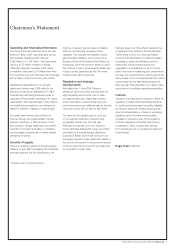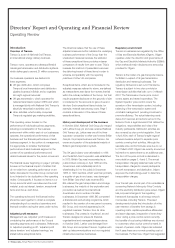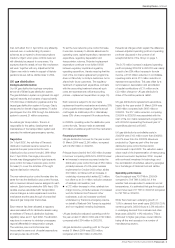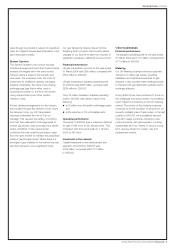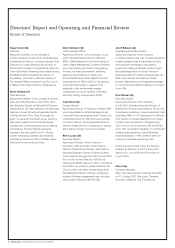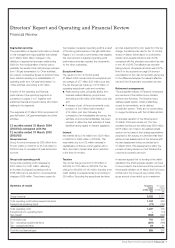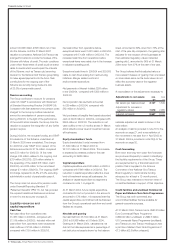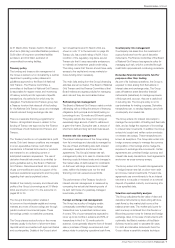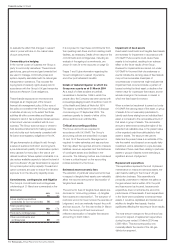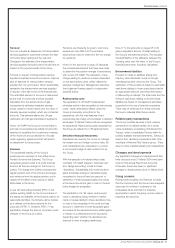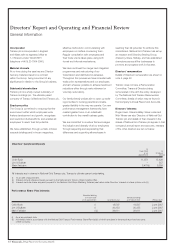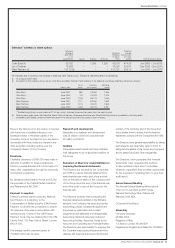National Grid 2004 Annual Report Download - page 13
Download and view the complete annual report
Please find page 13 of the 2004 National Grid annual report below. You can navigate through the pages in the report by either clicking on the pages listed below, or by using the keyword search tool below to find specific information within the annual report.
Financial review_continued
Tur nover
Turnover includes an assessment of transportation
services supplied to customers between the date
of the last meter reading and the year-end.
Changes to the estimate of the transportation
services supplied during this period would have an
impact on the reported results of the Group.
Turnover in respect of transportation services
supplied comprises amounts invoiced to shippers
plus an estimate for transportation services
supplied but not yet invoiced, which substantially
represents the transportation services supplied
in respect of the last month of the financial year.
The estimated element of turnover is determined
as the total of commodity services supplied,
calculated from the actual volume of gas
transported at estimated weighted average
prices, based on recent history and the value of
capacity services supplied, which are contracted
amounts. This estimate affects the UK gas
distribution and UK gas transmission segments.
Under UK GAAP, the Group is not permitted to
and has not recognised any liability for amounts
received or receivable from customers in excess
of the maximum amount allowed for the year
under regulatory agreements that will result in
an adjustment to future prices.
Pensions
The substantial majority of the Group’s
employees are members of the Lattice Group
Pension Scheme (the Scheme). The Group
recognises pension costs in its profit and loss
account as they are charged to the Group by
Lattice. The charge from Lattice comprises the
regular pension cost of the Group’s employees
and variations from the regular pension cost in
respect of the effect of any surplus or deficit
attributable to the Group.
A new UK accounting standard (FRS 17) will
replace existing GAAP. As the Group’s share of
the assets and liabilities of the Scheme cannot be
reasonably identified, the Scheme will be treated
as a defined contributions scheme for the
purposes of FRS 17. However, FRS 17 may
significantly change the amount of pension costs
charged to the Group by Lattice.
Pensions are inherently long term, and future
experience may differ from the actuarial
assumptions used to determine the net charge
for pensions.
Note 6 to the accounts on page 23 describes
the principal assumptions that have been used
to determine the pension charges in accordance
with current UK GAAP. The calculation of any
charge relating to pensions is clearly dependent
on the assumptions used, which reflects the
exercise of judgement. Management exercises
that judgement having regard to independent
actuarial advice.
Restructuring costs
The application of UK GAAP measurement
principles results in the recognition of restructuring
costs, mainly redundancy related, when the
Group is irrevocably committed to the
expenditure, with the main features of any
restructuring plan being communicated to affected
employees. If material, these costs are recognised
as exceptional. Restructuring costs recognised by
the Group are referred to in ‘Exceptional items’.
Derivative financial instruments
Derivatives are used by the Group to manage
its interest rate and foreign currency risks. All
such transactions are undertaken to provide
a commercial hedge of risks entered into by
the Group.
With the exception of indexed linked swap
contracts, UK GAAP applies a ‘historical cost’
and ‘hedge accounting’ model to these
‘derivatives’. Substantially, this model results in
gains and losses arising on derivatives being
recognised in the profit and loss account or
statement of total recognised gains and losses
at the same time as the gain or loss on the item
being hedged is recognised.
The application of a ‘fair value’ model would
result in derivatives being marked to market.
Gains or losses relating to these derivatives may
or may not be recognised in the profit and loss
account or statement of total recognised gains
and losses at the same time as any related gains
or losses on underlying economic exposures,
depending upon whether the derivatives are
deemed to have a hedging relationship.
Note 17 to the accounts on pages 28 to 30
gives a significant amount of detail relating to
the Group’s financial instruments. This includes
the identification of the difference between the
‘carrying value’ and ‘fair value’ of the Group’s
financial instruments, including ‘derivatives’.
Environmental liabilities
Provision is made for liabilities arising from
statutory decontamination costs of old gas
manufacturing sites owned by the Group. The
calculation of this provision is based on estimated
cash flows relating to those costs discounted at
an appropriate discount rate where the impact
of discounting is material. The total costs and the
timing of cash flows relating to environmental
liabilities are based on management estimates,
supported by the use of external consultants.
There may be variances from these amounts
that could materially affect future results.
Related party transactions
The Group provides services to and receives
services from its related parties. As a wholly
owned subsidiary undertaking of National Grid
Transco, which consolidates Transco within its
publicly available financial statements, Transco is
exempt from disclosing transactions with other
members of National Grid Transco group. There
were no other material related party transactions.
Changes and developments
Any significant changes and developments that
have occurred since 31 March 2004 have been
noted in this Annual Report and Accounts.
Otherwise, there have been no significant
changes or developments since 31 March 2004.
Going concern
Having made enquiries, the Directors consider
that the Company and the Group have adequate
resources to continue in business for the
foreseeable future and that it is therefore
appropriate to adopt the going concern basis in
preparing the accounts.
Annual Report and Accounts 2003/04_Transco plc 11


